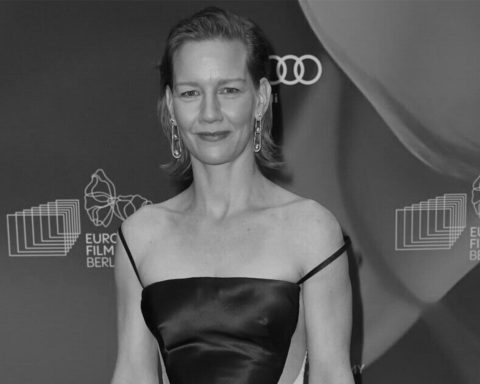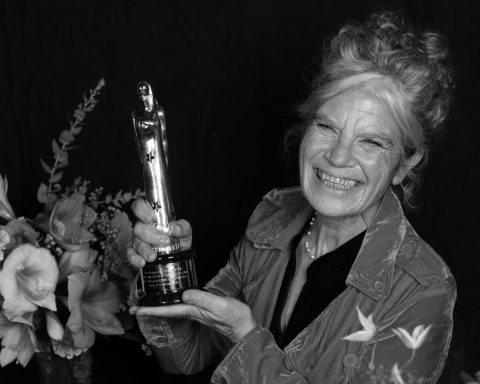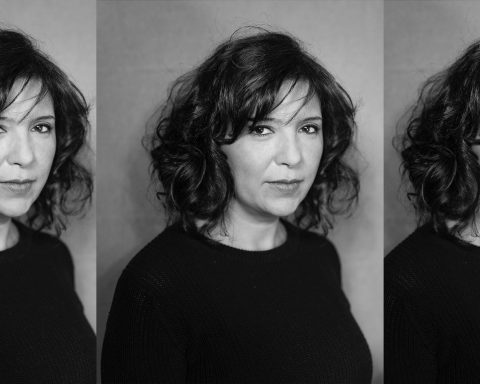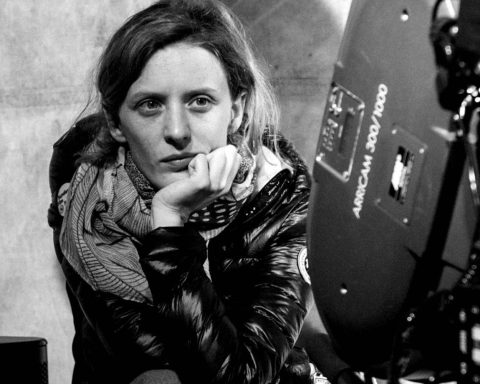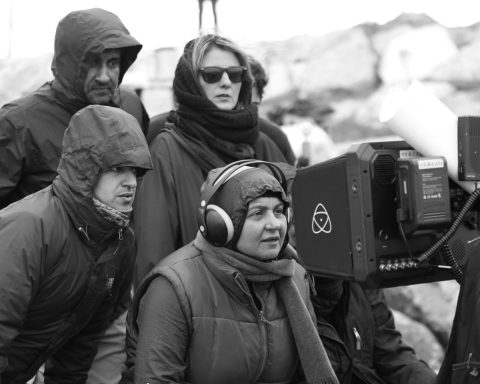Born in Mols, Denmark in 1985, Robin Petré first studied journalism at the Danish School of Media and Journalism in Aarhus and then Documentary Film Directing in the Doc Nomads program at universities in Portugal, Hungary and Belgium. Her films, which focus on the coexistence of humans with animals and nature, have screened at numerous international festivals and won a number of awards. She is an alumna of the Nordic Film Lab and the IDFAcademy.
Tara Karajica talks to Robin Petré about feminism and film and her poetic debut feature-length documentary, “From the Wild Sea,” in which volunteers work tirelessly to rescue Europe’s marine life from pollution and violent weather fuelled by climate change that premiered at the 2021 Berlinale, is now screening in the Europe! Voices of Women in Film at this year’s Sydney Film Festival and is shortlisted for the Sustainable Future Award.
How did you get into filmmaking?
Robin Petré: Actually, I studied Documentary Film Directing at Doc Nomads. It’s a Master’s Degree under the Erasmus Mundus European University coalition. Doc Nomads is a travelling Film School program. They bring in young people from all over the world and you study together at three different universities in three different European countries. So, it’s one semester in Lisbon, then one semester in Budapest and one semester in Brussels and then, we’re divided across these three countries to make our graduation film. And, that’s been very formative for me in terms of getting into the style of filmmaking that I do that is creative documentary filmmaking. But I’ve always been quite creative while growing up – drawing, writing and painting a bit. I also take a lot of pictures with old analogue cameras.
How did From the Wild Sea come about?
R.P.: I had been thinking about wild animal rescue for a long time. And, I was interested in it because I’m interested in the coexistence of human beings with wild animals and just how we coexist with nature in all kinds of different ways. There are so many things that are interesting about wildlife rescue, but first of all, it’s just very complex because there’s a contradiction in doing veterinary care on a wild animal as we’re not really supposed to interfere with their lives. But then again, there’s so much happening. Now that we’re in this emerging Anthropocene era where we’ve impacted nature so much and the habits of these wild animals are changing so much these days, I feel like maybe this line between when we should interfere with their lives is being pushed. I feel like there’s this change in our relationship with nature that is ongoing and it’s not just this film; it’s much bigger than this film. This film is one way, one region of the world, at one time, with some people doing one thing, but it’s really much bigger than that. I feel like our coexistence with wild animals is changing all over the world because the whole concept of nature and wilderness is changing.
In that sense, the documentary touches upon the humankind’s troubled coexistence with nature, as well as the detrimental impact of men on the marine environment through oil spills, plastic pollution, violent storms that are fueled by climate change. Can you talk about that?
R.P.: We definitely have a lot of impact on all these things, on the lives of these wild animals in their habitats and we also see that in the film. For instance, in the storms you mention, in the oil spill, it becomes very concrete. And, there are these concrete problems but, overall, there’s this transcending question of how we are supposed to live together on this planet as different species, and it’s very difficult. How can we find the wisdom to make the right decisions on when to interfere, when not to and how to deal with all these problems? We have our industrial impact on the planet and it’s just very difficult to draw the line between wild nature and human life.
From the Wild Sea is filmed from the perspective of the animals that are also the protagonists of the film, but your approach is somewhat cold and distant. Can you elaborate on that?
R.P.: What was really an interesting change for me as a filmmaker was to set out to film the people and the animals with the same feeling of distance or closeness in order not to make this distinguishing that we’re used to see in more conventional nature documentaries where you have human protagonists, and animals that are being translated into a language that we understand very easily. It’s usually that we translate the animals through verbal or written language. So, when we see an animal in a nature documentary, we normally have somebody explain it to us. What is this animal? Why is it behaving this way? Why is it moving that way? It’s not often that you see animals just exist within the frame of cinema. I was really interested in moving away from this more common nature documentary way of doing things and just present it from the point of view of animals and people. Of course, there are differences, but the film works with these long takes, with this relationship with distance in a way that doesn’t distinguish between the species. So, you have this feeling of observing the people and the animals and being observed back. So, there’s always someone looking back at you. And, that can be a person or a whale. So, this sort of distance was one thing that we were experimenting a lot with – how much distance should there be and how to construct it? Especially from the animal perspective because we’re so used to experiencing the world, but the animal perspective is, of course, somewhat neglected in this regard.
So, we worked a lot with this animal perspective – how to make it real – and I wanted to avoid adding human layers. I wanted to have those scenes as raw as possible, so it’s a still camera, a fixed frame, and there is a distance in these long takes, but it’s also because there’s an avoidance of editing all the time. It’s not edited in a way that directs you to think of this animal in a certain way. Rather, it’s a still, long take that sometimes lasts for several minutes, and just allows the animal to do whatever it does. So, that was one way of working with this animal perspective. There’s no music, there’s no text or voice-over or explanation of any kind. It’s totally clean in that sense. But, sometimes, there’s also a feeling of distance. I think it’s also very easy for us to get this feeling of distance because these animals are so different from us. My intention for the film is also to break down this feeling of distance to a degree where there are going to be moments sometimes for entire scenes, or just glimpses of a few seconds here and there were this distance dissolves and we hopefully can have this feeling of really stepping into the world of a seal or a dolphin for a little bit.
Can you talk about the title? Would it be fair to assume that it is about a message from the sea, something the sea wants to tell us?
R.P.: The title was actually something that took a really long time for us to come up with. All the previous titles were saying something about the sea like “the troubled sea,” but at one point, I realized that this whole film project was about the opposite movement, so it is really like you mentioned, something coming from the sea to us, maybe not as one particular message, but more as feeling that maybe we should listen to it. Filter the whole world through our own human prism, but allow something to come to us. And, another thing is also that all the animals are coming from the sea, they’re coming out of the sea, they’re washing up ashore to be found when they are hurt or sick. So, it’s really this movement of everything coming from the sea to us, the sea itself, the inhabitants…
What was the shooting process like? Can you talk about capturing climate change in action?
R.P.: Well, interestingly enough, the entire film, except for one scene, was filmed before the pandemic. And, it’s interesting because the film is so current. I feel that with this pandemic, most likely coming from wildlife – people had already been wearing all these masks and plastic suits, but it only became a common thing a year after the film was shot. It makes the film very relevant. It was strange to film during the climate change because what it does is that not only does it make the weather more violent at times, but it also makes more unpredictable. Sometimes, in January, for instance, when there was supposed to be a storm, it was suddenly quiet and warm. It was unusually warm and it felt like April weather – just sunshine, mild temperatures and spring flowers that started blooming in England where we were at the time. And, we were there, with our camera, supposed to film winter storms, which are usually a safe bet in January, and that didn’t happen. And then, the next one’s late February, late in the season, and the storms came with an extreme force and closed down England.
What is interesting in the film is that you show successful rescues, but also deaths. Can you delve into how you achieved this very realistic balance?
R.P.: Honestly, I think this is one of the most difficult editing decisions – when to show death and how much and when in the film you can bring in the deaths. It’s a point zero; there are not many places you can go after. A death is really hard to get on after. How do you start the next scene? How do you continue your film after that because you’re at the absolute peak of disaster? It’s a dead end, literally. So, it was something we worked a lot with – where to place it? At the same time, the animals, the truth is that some of them die. It’s not uncommon. It’s not like it’s a rare thing; it happens quite a lot. That said, what they do for instance in this youth center is that they rescue the majority, but death is definitely very much a part of this work and I was not okay with stepping out of this entire feature film without including that at all, because that’s just not truthful. And, also the human impact on the habitats and the nature, at this point, is causing a lot of deaths as well and it’s very serious. There are many animals in the film that are recovering and being let out again. And there are also even comical moments and lighter moments, and I hope it’s this kind of film that people can find both comical and sad. It was important to not stay on one level. It is a lot of things; there are also happy stories, the animals are so cute, endearing even funny, but there is also this consequence. They’re in a hospital. They’re not there for our entertainment. It is a game of life and death, really.
There has been so much talk about women in film in the past four years. What is your take on the matter? How is it in documentaries? How is it in Denmark?
R.P.: Things are definitely changing, especially with the #metoo movement, which I really support personally and I’m really grateful that this movement has been able to bring about so much awareness across borders and across different industries. The film industry has been male-dominated for many years. Interestingly, it’s not entirely how it was when film started, when it was such a new art form in the early 1900s. There are strong women in film, but I feel that men have definitely dominated film as an art form and medium for a long time. In documentary, it’s a bit different from fiction where there’s definitely much more male dominance. Denmark is also putting a lot of attention on this and trying to put efforts into levelling things out more, but we still have a majority of male funding recipients and male directors. I feel, also in my own experience and the experience of my close friends and colleagues who are women in film, that we have to prove ourselves more all the time, especially when you’re an upcoming filmmaker. And, in that process, sometimes, doors are maybe more easily closed to you. And, it’s not because men don’t want us there; I think it’s more of a psychological state of having kept positions for so many years and not necessarily wanting to deliberately make it so, but they have been a part of a system that has been created to facilitate the growth of men more easily than that of women. Psychologically, we’re just more prone to hire someone that resembles ourselves and we’re not even aware of it. It’s just so deeply ingrained in our psyche that we just feel more comfortable with someone who resembles us in the room. So, men are more likely to hire other men. So, if men have all the power positions, how are doors going to be opened to the women taking those power positions and then sharing them with men? I definitely feel that as, a woman, you have to prove yourself over and over again for a longer time and more intensely than some of my male counterparts.
Do you have a favorite female filmmaker and a favorite film by a female filmmaker?
R.P.: Agnès Varda.
What are your next projects?
R.P.: I’m working on several things, but I’m also developing another film that continues this cinematic exploration of the relationship between nature and human beings. While From the Wild Sea is a very cold film, this one is a totally different project. It’s not about the ocean, but it’s similar in the sense that it is also exploring, to a certain degree, the relationship between humans and animals.
Photo credits: Maria Grazia Goya.
This interview was conducted in partnership with:

and







